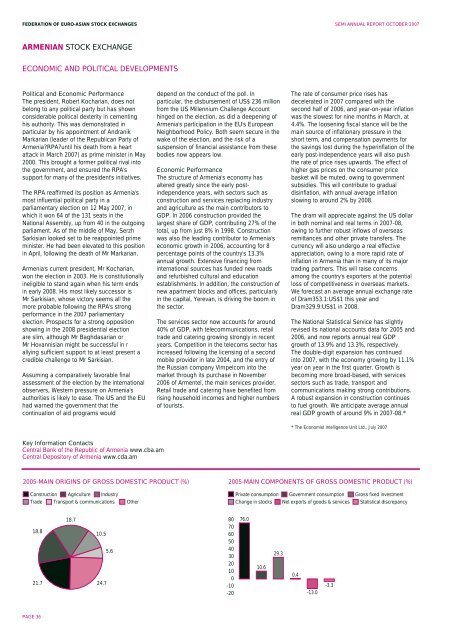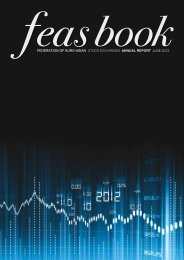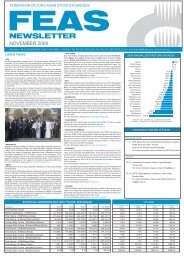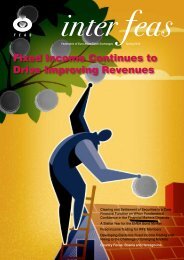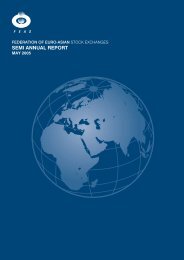Download - FEAS
Download - FEAS
Download - FEAS
- No tags were found...
You also want an ePaper? Increase the reach of your titles
YUMPU automatically turns print PDFs into web optimized ePapers that Google loves.
FEDERATION OF EURO-ASIAN STOCK EXCHANGES SEMI ANNUAL REPORT OCTOBER 2007ARMENIAN STOCK EXCHANGEECONOMIC AND POLITICAL DEVELOPMENTSPolitical and Economic PerformanceThe president, Robert Kocharian, does notbelong to any political party but has shownconsiderable political dexterity in cementinghis authority. This was demonstrated inparticular by his appointment of AndranikMarkarian (leader of the Republican Party ofArmenia?RPA?until his death from a heartattack in March 2007) as prime minister in May2000. This brought a former political rival intothe government, and ensured the RPA'ssupport for many of the president's initiatives.The RPA reaffirmed its position as Armenia'smost influential political party in aparliamentary election on 12 May 2007, inwhich it won 64 of the 131 seats in theNational Assembly, up from 40 in the outgoingparliament. As of the middle of May, SerzhSarkisian looked set to be reappointed primeminister. He had been elevated to this positionin April, following the death of Mr Markarian.Armenia's current president, Mr Kocharian,won the election in 2003. He is constitutionallyineligible to stand again when his term endsin early 2008. His most likely successor isMr Sarkisian, whose victory seems all themore probable following the RPA's strongperformance in the 2007 parliamentaryelection. Prospects for a strong oppositionshowing in the 2008 presidential electionare slim, although Mr Baghdasarian orMr Hovannisian might be successful in rallying sufficient support to at least present acredible challenge to Mr Sarkisian.Assuming a comparatively favorable finalassessment of the election by the internationalobservers, Western pressure on Armenia'sauthorities is likely to ease. The US and the EUhad warned the government that thecontinuation of aid programs woulddepend on the conduct of the poll. Inparticular, the disbursement of US$ 236 millionfrom the US Millennium Challenge Accounthinged on the election, as did a deepening ofArmenia's participation in the EU's EuropeanNeighborhood Policy. Both seem secure in thewake of the election, and the risk of asuspension of financial assistance from thesebodies now appears low.Economic PerformanceThe structure of Armenia's economy hasaltered greatly since the early postindependenceyears, with sectors such asconstruction and services replacing industryand agriculture as the main contributors toGDP. In 2006 construction provided thelargest share of GDP, contributing 27% of thetotal, up from just 8% in 1998. Constructionwas also the leading contributor to Armenia'seconomic growth in 2006, accounting for 8percentage points of the country's 13.3%annual growth. Extensive financing frominternational sources has funded new roadsand refurbished cultural and educationestablishments. In addition, the construction ofnew apartment blocks and offices, particularlyin the capital, Yerevan, is driving the boom inthe sector.The services sector now accounts for around40% of GDP, with telecommunications, retailtrade and catering growing strongly in recentyears. Competition in the telecoms sector hasincreased following the licensing of a secondmobile provider in late 2004, and the entry ofthe Russian company Vimpelcom into themarket through its purchase in November2006 of Armentel, the main services provider.Retail trade and catering have benefited fromrising household incomes and higher numbersof tourists.The rate of consumer price rises hasdecelerated in 2007 compared with thesecond half of 2006, and year-on-year inflationwas the slowest for nine months in March, at4.4%. The loosening fiscal stance will be themain source of inflationary pressure in theshort term, and compensation payments forthe savings lost during the hyperinflation of theearly post-independence years will also pushthe rate of price rises upwards. The effect ofhigher gas prices on the consumer pricebasket will be muted, owing to governmentsubsidies. This will contribute to gradualdisinflation, with annual average inflationslowing to around 2% by 2008.The dram will appreciate against the US dollarin both nominal and real terms in 2007-08,owing to further robust inflows of overseasremittances and other private transfers. Thecurrency will also undergo a real effectiveappreciation, owing to a more rapid rate ofinflation in Armenia than in many of its majortrading partners. This will raise concernsamong the country's exporters at the potentialloss of competitiveness in overseas markets.We forecast an average annual exchange rateof Dram353.1:US$1 this year andDram329.9:US$1 in 2008.The National Statistical Service has slightlyrevised its national accounts data for 2005 and2006, and now reports annual real GDPgrowth of 13.9% and 13.3%, respectively.The double-digit expansion has continuedinto 2007, with the economy growing by 11.1%year on year in the first quarter. Growth isbecoming more broad-based, with servicessectors such as trade, transport andcommunications making strong contributions.A robust expansion in construction continuesto fuel growth. We anticipate average annualreal GDP growth of around 9% in 2007-08.** The Economist Intelligence Unit Ltd., July 2007Key Information ContactsCentral Bank of the Republic of Armenia www.cba.amCentral Depository of Armenia www.cda.am2005-MAIN ORIGINS OF GROSS DOMESTIC PRODUCT (%)2005-MAIN COMPONENTS OF GROSS DOMESTIC PRODUCT (%)Construction Agriculture IndustryTrade Transport & communicationsOtherPrivate consumption Government consumption Gross fixed investmentChange in stocks Net exports of goods & services Statistical discrepancy18.821.718.710.524.75.680706050403020100-10-2076.010.629.30.4-13.0-3.3PAGE 36


